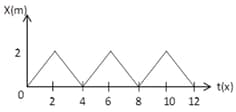Impulse of a Force
Impulse of a Force: Overview
This topic covers concepts such as Linear Impulse, Linear Impulse of Constant Force, Linear Impulse of Time Varying Force, and Linear Impulse from F-t Diagrams.
Important Questions on Impulse of a Force
A ball of drops vertically on the floor with a speed of . It rebounds with a velocity of .
What impulse acts on the ball during contact?
Starting from rest, a car moves with a constant acceleration, and comes to a momentary stop with the same constant deceleration. Subsequently, it reverses its motion and returns to its original position in a similar manner. Which one of the following graphs of momentum versus time best describes the motion of the car?
Two billiard ball each of mass moving in opposite directions with speed collide and rebounds with the same speed. The magnitude of impulse imparted to each ball due to other is
Figure shows the position–time graph of one dimensional motion of a body of mass . What is the time interval between two consecutive impulses received by the body?
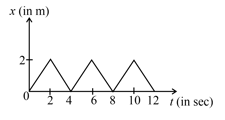
A batsman hits back a ball of mass straight in the direction of the bowler without changing its initial speed of . If the ball moves in same straight line, then the impulse imparted by it (in ) is,
The figure shows the position-time graph of one-dimensional motion of a body of mass The interval between two consecutive impulses received by the body would be
A body of mass 10 kg is acted upon by a given equation Newton. The initial velocity of the body is 10 m/s. The velocity of the body after 5 sec is
At time t second, a particle of mass 3 kg has position vector metre where . The impulse of the force during the time interval is
A body of mass 5 kg is acted on by a net force F which varies with time t as shown in graph, then the net momentum in SI units gained by the body at the end of 10 seconds is
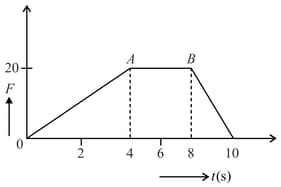
A body of has an initial speed . A force acts on it for in the direction of motion. The force-time graph is shown in figure. The final speed of the body after is
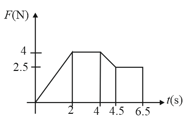
A ball of mass moving with a velocity rebounds from a wall. The collision is assumed to be elastic and the force of interaction between the ball and wall varies as shown in the figure. Then the value of is -
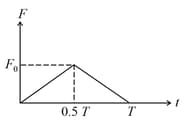
Two point masses connected by an ideal string are placed on a smooth horizontal surface as shown in the diagram. A sharp impulse of is given to the mass. The velocity of the mass will be -

A sping balance is adjusted at zero. Elastic collisions are brought about by dropping particles of one gram each on the pan of the balance. They recoil upwards without change in their speed. If the height of fall of particles is and the rate of particle dropping is per second, then the reading of the balance is (take )
While waiting in a car at a signal, an man and his car are suddenly accelerated to a speed of due to a rear-end collision by another vehicle. If the time of impact is , the average force on the man is
A disc of mass is kept floating horizontally in the air by firing bullets, each of mass , with the same velocity at the same rate of bullets per second. The bullets rebound with the same speed in positive direction. The velocity of each bullet at the time of impact is
A player kicks a football of mass and the football begins to move with a velocity of . If the contact between the leg and the football lasts for Then the force on the ball should be
A force-time graph for a linear motion of a body is shown in the figure. The change in linear momentum between and is
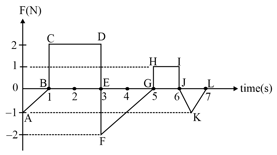
A hockey player receives a corner shot at a speed of at an angle of with the -axis and then shoots the ball of mass 100 g along the negative -axis with a speed of . If it remains in contact with the hockey stick for 0.01 s, the force imparted to the ball in the -direction is
A unidirectional force varying with time as shown in the figure acts on a body initially at rest for a short duration. Then the velocity acquired by the body is
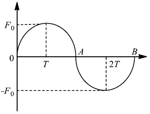
A rocket in free space expels of gas per second at exhaust velocity for seconds. What is the increase in the speed of rocket in this time (assume time interval is too small to consider variation in acceleration)

